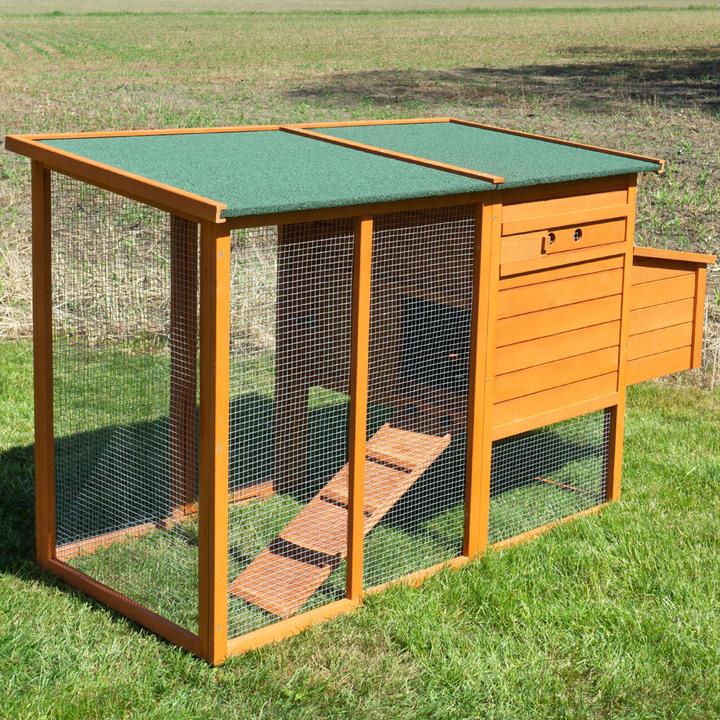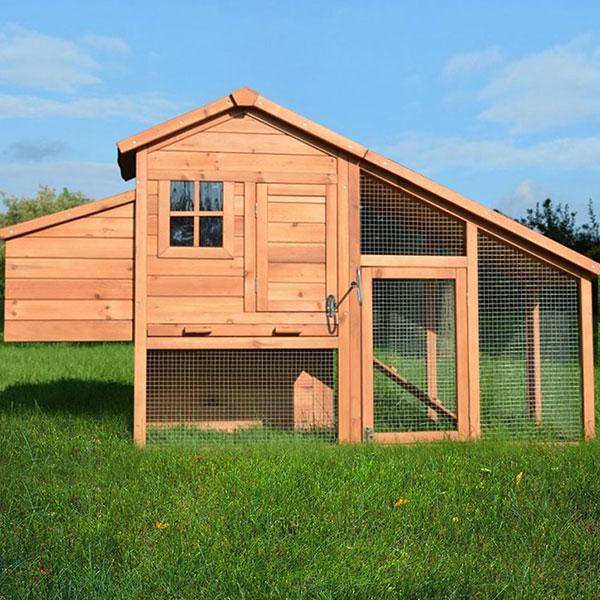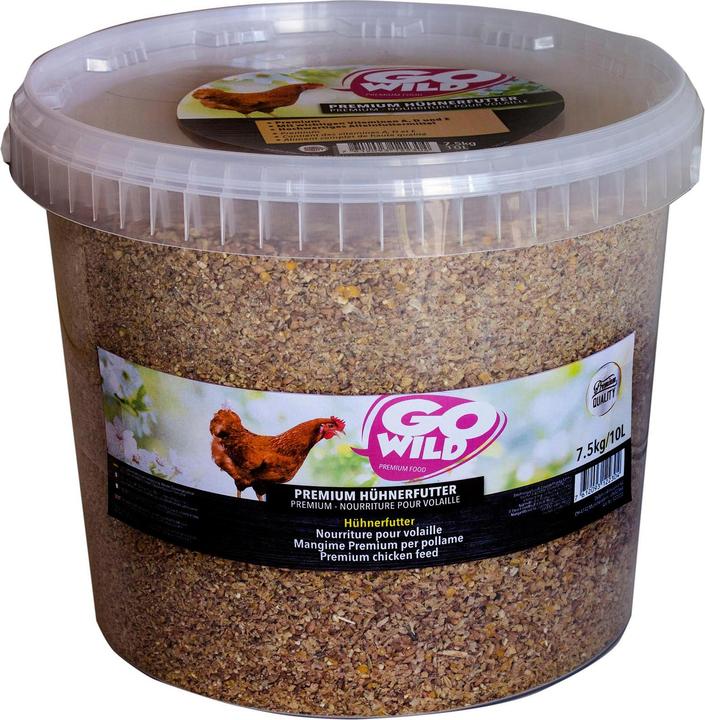

Fan of fresh eggs? Keep your own chickens
There’s a German children’s song that goes «my grandma drives her motorcycle in the chicken coop». Let’s be clear: motorcycles certainly don’t belong in a chicken coop. But if you really are thinking of keeping your own chickens, here are some tips for you.
Which came first, the chicken or the egg? This fundamental question, which mankind has been pondering since ancient times, has an easy answer – at least at home. The starting point was our wish to have our own supply of eggs.
And to get eggs, you need a chicken. Or, better yet, several chickens. No sooner said than done. For a few years now, we’ve been proud chicken parents together with our neighbours. Our chickens are the gift that, depending on the season, keeps on giving us fresh eggs with the yellowest of yolks on the daily. To be fair, we live in a rather rural area, so we’ve got the necessary space. On top of that, it’s not all quite as quickly done as it may sound so far. Keeping chickens isn’t necessarily complicated and difficult per se. But it does require some preparation, regular upkeep and patience.

Choose your chicken wisely
A chicken is not just a chicken. In Europe alone, there are over 180 different breeds of mankind’s most common pet: the domestic chicken. According to Wikipedia, the average daily population of chickens worldwide is estimated at over 20 billion. That comes out to three chickens per person. The essential difference between the different breeds is their purpose. Especially in the field of meat production, there are cases of absurd and inhumane overbreeding – an example being the chicken consisting just about solely of chicken breast. You could write a novel about these mass-produced chickens, but this article is about keeping chickens as a private individual.
First off, you’ll want a chicken that lays eggs regularly. There are several breeds suited to this purpose, such as the typical Swiss breed the Schweizer. It can lay up to 200 eggs per year, is considered calm and trusting, and you’d also be contributing to the preservation of the breed by keeping it. Ultimately, however, the choice of chicken comes down to taste. What I would like to suggest to you, however: get a classic farming breed. The «Züchterverein für ursprüngliches Nutzgeflügel» (English: association of original farming poultry breeders) offers more information about the respective breeds on its website. Under no circumstances should you let a hybrid be foisted on you, as happened to us with our first generation of chickens.
Hybrid chickens have been selectively bred to produce as much meat or as many eggs as possible in a short span of time. Lots of eggs are great, but we also want the animal to be well and to live as long as possible. Besides, we don’t need maximum output in minimum time. In industrial farming, hybrid chickens are slaughtered after about a year because they start to underperform in terms of egg-laying. Not all even make it to one year ... Due to overbreeding, hybrids are also much more susceptible to disease than the old, robust breeds. Add to all that the fact that no one in our household would be capable of slaughtering any of our chickens.
All this to say: invest the time to find the right chicken for you as well as a reputable seller. It’s worth it. Oh, heaven forbid you forget the obligation to register your chicken! It’s mandatory in Switzerland. You can get this done at the veterinary office of your canton of residence.
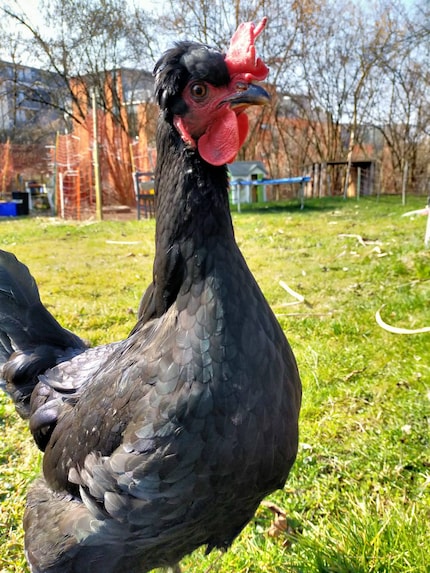
Cock-a-doodle-doo
If you want to buy chickens, you should also think about whether you want a rooster – emphasis on want, because you don’t need one unless you’re aiming for reproduction. Our first four hens were perfectly happy laying eggs without a rooster. Personally, I never wanted a rooster, but we ended up with one anyway. It’s not easy to tell the sex of a chick! Long story short, Nicki eventually became Travis. Here are the two most important things I’ve learnt as an accidental rooster owner:
- The beast crows! And not just early in the morning, but whenever the mood strikes him, all day long. It can get quite loud. Most people get used to this sooner or later and ignore the croaking «cock-a-doodle-doo». But we have had an annoyed neighbour show up at our front door before to complain about the noise. Ideally, talk to your neighbours about getting a rooster before actually getting one.
- If you have a rooster, be sure to remove the eggs from the coop regularly, preferably daily. If you don’t, you’ll end up with fertilised eggs sooner or later, chicks about three weeks after that – and that’s when things get really complicated. If you let the chickens out of the coop every day and back in again in the evening anyway, might as well do a quick scan for freshly laid eggs.
Other than that, there’s not much speaking against owning a rooster. It won’t get in the way of the social cohesion of a flock of hens, either; without one, the hens will just organise themselves.
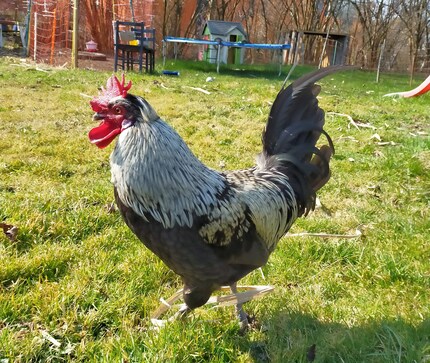
You make your bed, then you lie in it
If you decide to treat yourself to chickens, you’ll have to treat them to a coop. They need one for a number of reasons. Even if they spend the whole day outside with no issues, when dusk hits, they’re drawn to the indoors. Chickens, too, prefer to sleep in a dry, not-too-cold place, and they prefer to lay their eggs in a coop. A coop conveys security, both to the chickens and to you. After all, you don’t want the fox to get ahold of your chickens.
When it comes to coops, you’re spoilt for choice – you’ll find a range of ready-made models in our online shop. Or you can opt to build one yourself according to your own design. Our first coop was a ready-made one and was great for the chickens, but not so great for us humans. The enclosure was so deep that our weekly cleaning forced us into a mix of horizontal and crouched positions, not helped by the fact that both my neighbour and I are close to two metres tall. In the meantime, we’ve found a much better solution. We ordered a garden shed and repurposed it into a chicken coop.
First and foremost, what the chickens need inside the coop is a place to sleep, namely an elevated bar. It, too, gives them a sense of safety, and it’s where they spend the night, snuggled up to each other. Just below the bar is the so-called dropping board, a collection tray for the sleeping fowls’ poop. You’ll have to cover the floor of the coop with bedding to absorb moisture. We also put out hay; the chickens like to peck at it, and it also absorbs moisture. All that’s left to add now is a water trough and feeding station, and your chicken chalet is good to go.
And now, the most important thing to keep in mind when building a coop in Switzerland: most buildings require a permit whose allowance is typically quite small and dependent on the canton. To play it safe, check with your municipality in advance. In the worst-case scenario, you might have to tear down your chicken coop or be hit with a fine.
«I believe I can fly»
So, you’ve got all you need to keep chickens. Let me just give you a few final tips:
- Every now and then (at least once a year), you should lime the chicken coop. Limewash has a disinfecting effect. You can use it to get rid of mould, parasites such as bird mites, and more.
- Chickens can fly. It sounds wrong, but it’s true. By now, the fence around our chicken’s run is a good 1.60 metres tall. And yet, one of our feathered femmes still manages to find her way over and sit about on the other side of the fence. So, if you don’t want chickens making your whole yard unsafe, gear up with a fence or net.


Siena Garden Hexagonal braids
- Pamper your chickens once in a while. In addition to the usual feed mix of grains and chicken food for laying hens that they should have at all times, indulge them with some mealworms (which are also a great way to lure your chickens back to where they should be).
- Chickens like to scratch. A lot. This is an innate drive related to foraging and another reason for you to limit their run. What you can do, for example, is put out a crate of fine grain sand for them within their designated area. This’ll give the chickens the opportunity to live out their drive while also taking a sand bath. By rolling in the sand, chickens clean their feathers.
- Be aware that keeping chickens, like keeping any other pet, is a commitment. There’s a lot to organise any time you want to travel. Simply opening the coop door in the morning and closing it again in the evening isn’t a big problem, and neither is replenishing the food and water. But finding someone to muck out and clean the coop is on another level. As the saying goes: marry in haste, repent at leisure.
Admittedly, I didn’t originally want to be a part-time chicken farmer at all. Alas, I was democratically outvoted in my home. In retrospect, I’m glad I was, especially since my initial concerns weren’t confirmed. It’s not an absurd amount of work, and the smell in and around the chicken coop isn’t half as bad as I’d feared either. Chickens live modestly; if you give them what they need, they’ll supply you with fresh eggs as thanks. Sure, chickens will probably never be the kind of cuddly balls of fluff that cats and dogs are, but these mini dinos really do grow on you.

Alright, I’m off to tend to Nuggets, Wings, Uschi, Cardi and Travis. It’s my turn to muck out the chicken coop ... and no, I won’t be riding in on my motorcycle.
I'm a full-blooded dad and husband, part-time nerd and chicken farmer, cat tamer and animal lover. I would like to know everything and yet I know nothing. I know even less, but I learn something new every day. What I am good at is dealing with words, spoken and written. And I get to prove that here.
Practical solutions for everyday problems with technology, household hacks and much more.
Show all